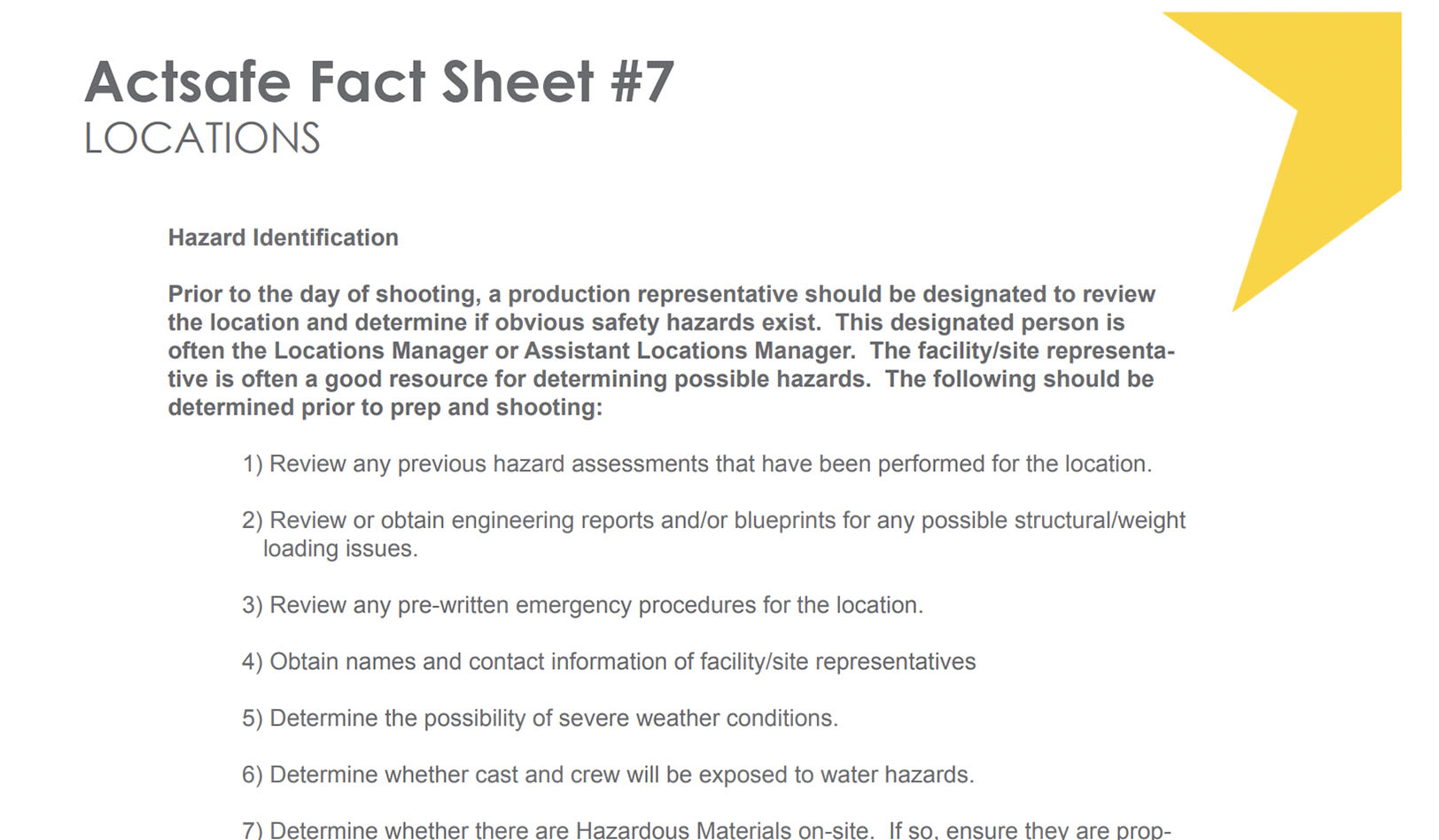HAZARD IDENTIFICATION
Prior to the day of shooting, a production representative should be designated to review the location and determine if obvious safety hazards exist. This designated person is often the Locations Manager or Assistant Locations Manager. The facility/site representative is often a good resource for determining possible hazards. The following should be determined prior to prep and shooting:
- Review any previous hazard assessments that have been performed for the location.
- Review or obtain engineering reports and/or blueprints for any possible structural/weight loading issues.
- Review any pre-written emergency procedures for the location.
- Obtain names and contact information of facility/site representatives
- Determine the possibility of severe weather conditions.
- Determine whether cast and crew will be exposed to water hazards.
- Determine whether there are Hazardous Materials on-site. If so, ensure they are properly and securely stored and there are Material Safety Data Sheets (MSDS) immediately available at the location.
- Determine whether there are Asbestos Containing Materials (ACM) or lead paint present. If there are, determine the possibility of exposure by cast and crew.
- Identify any potential walking surface hazards.
- Determine areas that should be off-limits to cast and crew and ensure barriers are placed and/or “Keep Out” signs are posted.
- Ensure any exits, corridors and stairs are properly illuminated.
- Ensure guardrails/handrails are in-place on any elevated platforms and steps.
- Determine whether any confined spaces will be used.
- Determine whether supplementary ventilation will be necessary.
- Identify potential live electrical hazards.
- Determine whether fire protection equipment (Extinguishers etc.) are available, serviceable, and updated. (Class C extinguishers should be available next to electrical panels/equipment).
- Determine whether sprinkler systems are active and ensure heads are not obstructed.
- Determine whether security will be required.
- Ensure adequate lighting will be available when prepping/shooting at night.
- Determine the level of first aid that will be required for the location.
- Determine if traffic control will be necessary.
- Determine whether Actsafe Safety Bulletins or Fact Sheets will need to be posted on call sheets.
- Ensure adequate flush or chemical toilets with hand-washing facilities will be made available for all employees on location.
Safety Considerations on the Day of Shooting:
- Ensure the WorkSafeBC “Notice of Project” and the AHJ filming permit is posted in a common area of the location.
- Ensure that required production safety notifications/manuals are available on set.
- The 1st Assistant Director must conduct a safety meeting prior to shooting to communicate the safety/emergency plan, any hazards associated with the location and any production generated hazards (stunts, special effects etc).
- According to WorkSafeBC, all workers on a location are considered “new workers” and must be specifically oriented to that location. SHAPE has created a checklist that ensures that each worker has been properly oriented. These orientations must be documented either on the checklists or on the daily production report.
- Ensure exterior fire lanes are kept clear.
- For interior locations, ensure a clear path of egress is kept to all exits.
- Ensure and adequate supply of safe drinking water is readily available to all employees on location.
- Ensure holding areas are properly heated and ventilated with suitable emergency escapes and seating capacity.
- Cast and crew exposed to long hours in adverse exterior conditions (heat or cold stress) should be provided with appropriate items to combat such adverse conditions (ie., temporary shelter, heated washroom facilities, temporary heating devices, hot shots, hot drinks, blankets, adequate fluids, etc.) See Appendix B.
- Ensure all cables and similar items are channeled neatly and safely.
- All portable electric heaters used must be equipped with safety tip-over switches.
- All winnies, honeywagons, temporary wardrobe units, etc. must be operated and properly set-up by qualified persons (driver/operator).
Permitting:
Forward your Registration Form to all jurisdictions in which the production will be filming (ie. City of Vancouver Film Office, or City of Burnaby Film Office). Visit their websites for Guidelines and Procedures.
Outline any special effects or gunfire associated with the proposed location (note: approvals for these activities may take extra time to process).
Additional Reference:
Regional Health Authorities and the BC Health Act
Food Premises Regulation Craft Service Vehicles, which include but are not limited to trailers, converted motor homes, or other self-contained units, may be required to meet the description of a Food Service Establishment as defined in the BC Food Premises Regulation. For this reason, the owner/operator of the vehicle must apply to the local Health Authority for approval and to obtain a valid “Permit to Operate”. http://www.health.gov.bc.ca/socsec/contacts.html
Actsafe
Actsafe is the not-for-profit association dedicated to the promotion of health and safety in the motion picture, theatre, music and other performing arts industries. Actsafe operates through two Standing Committees that represent the Motion Picture and the Performing Arts communities respectively. https://www.actsafe.ca 604.733.4682
Traffic Control
Most highway shoots require the use of certified traffic control personnel. On roadways within municipal jurisdictions, producers may have to contract local police to provide traffic control. https://www2.gov.bc.ca/gov/content/transportation/transportation-infrastructure/engineering-standards-guidelines/traffic-engineering-safety
Contact list:
For a list of contacts, including emergency and municipal regulatory bodies, please contact the BC Film Commission office in your jurisdiction. A listing of regional BC Film Commission offices can be found online at: https://www.creativebc.com/contact-us/crbc-contacts#provincial-film-commission



Share Now: